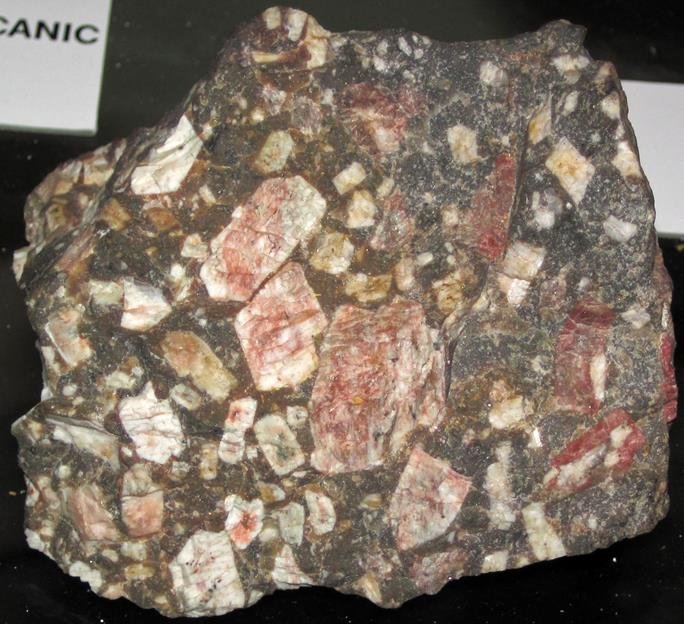Porphyritic trachyte rocks have large, well-formed sanidine, plagioclase, and sometimes amphibole, biotite, or pyroxene crystals in a fine-grained matrix.
The matrix comprises alkali feldspar, lesser plagioclase with minor augite (or other pyroxenes), hornblende, biotite, and sometimes olivine.
Also, this groundmass may have a small amount of quartz and accessory minerals like apatite, ilmenite, zircon, titanite, or magnetite.
We call the large crystals phenocrysts. These crystals are well-formed or euhedral to subhedral, indicating they grew without restriction from neighboring mineral crystals.
On the other hand, the finer-grained matrix is known as groundmass. These likely grew later or nucleated more but grew slowly.
In trachyte, sanidine is the common alkali feldspar. However, orthoclase or anorthoclase may occur, while plagioclase is oligoclase or varieties richer in sodium. Both these alkali feldspars and plagioclases occur as phenocrysts or in the groundmass.
Porphyritic or phyric is an adjective from the noun porphyry or phyre. You can also use the suffix porphyry with the rock name, i.e., trachyte porphyry.

About trachyte
Trachyte is usually a fine-grained volcanic rock that forms on the Earth’s surface. Its composition lies between the silica-rich felsic and silica-poor mafic rocks.
However, it often has other textures, such as trachytic, glassy, porphyritic, or pumiceous.
Trachytic texture has aligned, nearly parallel sanidine microlites (minute crystals) that swirl around phenocrysts. They show the direction of flow or compaction.
On the other hand, a glassy texture forms when magma is quenched so rapidly that it doesn’t crystallize. Instead, the melt freezes in place, forming an amorphous solid, i.e., volcanic glass.
What about orthophyric texture? It has short, squarish, or stubby rectangular prisms of sanidine or alkali feldspar microlites.
Lastly, pumiceous texture describes a low-density, highly vesicular, foam or froth-like glassy rock. It forms from the rapid quenching of gas-rich lava.
How does trachyte porphyry form?
The bimodal grain sizes in trachyte porphyry form from a two-stage cooling.
The first cooling stage is slow and deep inside the Earth’s cooling. Thick overlaying rock insulates magma, making magma cool slowly.
The slow cooling results in a slow nucleation rate and allows any crystals that nucleate to grow large. This forms large crystals or phenocrysts.
Phenocrysts are well-formed since most of the magma is still liquid. Therefore, crystals grow unrestricted, forming easy-to-recognize crystal faces.
The second cooling stage is fast. It occurs when magma erupts on the Earth’s surface where cooling is slow.
The slow cooling favors high nucleation. However, there is no time or space for large crystals to grow. Therefore, it forms a fine-grained matrix.
Where does this rock occur?
Trachyte porphyry forms at continental rifts, hotspots, and volcanic arcs. Also, some can occur in oceanic islands or anywhere with alkali basalt magma.
These rocks will form as lava flows, pyroclastic deposits, shallow dikes, or sills.
Going to specific locations, this rock occurs in East Africa, Rift Valley, Gardar, and Rio Grande Continental. Also, they occur in the Aegean, Campanian, and Aeolian volcanic arcs.
Some places where it occurs in the US include Big Bend, Chisos, and Davis Mountains in Texas. Also, it occurs in the Black Hills in Dakota and Nevada.
How are porphyritic trachyte rocks used?
The porphyritic texture doesn’t affect the properties of the rocks in which it occurs. Therefore, you can use it like the aphyric trachytes, i.e., non-porphyritic.
These uses include dimensional stone for building, paving, or facing. They can also form aggregate for various uses, but not concrete, being higher in silica.
